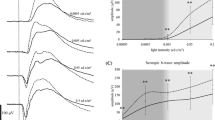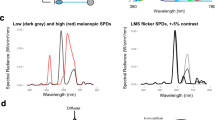Summary
-
1)
The electroretinogram (ERG) of Paravespula germanica is a monophasic negative potential, which has negative peaks at light-on and light-off. It can be argued that the on-peak and the continuous plateau potential for the greater part is an extra-cellular mass potential of the receptors, while the off-effect originates in the lamina.
-
2)
After adaptation to Xenon light the relative spectral sensitivity varies only slightly, the decrease is relatively greatest in the UV-range.
-
3)
Through selective spectral adaptation three different types of color receptors can be isolated from the evaluation of the on-peak and plateau potential: an UV-receptor (λ max=374 nm), a blue-receptor (λ max=455 nm) and a green-receptor (λ max=530 nm, a second lower maximum: 389 nm).
-
4)
The off-effect of the ERG can be selectively adapted only by UV.
-
5)
All color receptors described in the literature are compared in the discussion. The differences in chromatic adaptation at on- and off-peaks are hypothetically attributed to different types of connections of the retinula axons in the lamina.
Zusammenfassung
-
1.
Das ERG von Paravespula germanica ist ein monophasisch negatives Potential, das bei Licht-an und Licht-aus negative Spitzen aufweist. Die Ein-Spitze und das anhaltende Plateau-Potential ist überwiegend ein extrazelluläres Summenpotential der Rezeptoren, der Aus-Effekt hat ganglionären Ursprung.
-
2.
Durch Helladaptation mit Xenonlampenlicht ändert sich die relative spektrale Empfindlichkeit nur wenig; am meisten noch in UV-Bereich.
-
3.
Mit selektiver spektraler Adaptation lassen sich aus der Ein-Spitze und dem Plateaupotential drei verschiedene Farbrezeptoren isolieren: ein UV-Rezeptor (λ max=374 nm), ein Blaurezeptor (λ max=455 nm) und ein Grünrezeptor (λ max= 530 nm, Nebenmaximum: 389 nm).
-
4.
Der Aus-Effekt des ERGs dagegen kann selektiv nur mit UV-Licht adaptiert werden.
-
5.
Die Diskussion bringt einen Vergleich mit den bisher beschriebenen Farbrezeptoren der Insekten. Die Unterschiede bei der chromatischen Adaptation von Ein- und Aus-Spitze werden hypothetisch auf die ungleichartige Verschaltung der Retinulaneurite in der Lamina zurückgeführt.
Similar content being viewed by others
Literatur
Armbruster, L.: Über den Farbensinn der Wespen. Naturw. Wschr. 21, 419–422 (1922).
Autrum, H. J.: Physiologie des Sehens. Fortschr. Zool. 13, 257–290 (1961).
—: Colour vision in animals and man. Naturwissenschaften 55, 10–18 (1968).
—, Kolb, G.: Spektrale Empfindlichkeit einzelner Sehzellen der Aeschniden. Z. vergl. Physiol. 60, 450–477 (1968).
—, Zwehl, V. v.: Spektrale Empfindlichkeit einzelner Sehzellen des Bienenauges. Z. vergl. Physiol. 48, 357–384 (1964).
Barlow, H. B.: The size of ommatidia in apposition eyes. J. exp. Biol. 29, 667–674 (1962).
Beier, W., Menzel, R.: Über den Farbensinn der Deutschen Wespe, Paravespula germanica F.: Verhaltensphysiologischer Nachweis des Farbensehens. (In Vorbereitung.)
Bennett, R. R.: Spectral sensitivity studies on the whirligig beetle, Dineutes ciliatus. J. Insect Physiol. 13, 621–633 (1967).
—, Tunstall, J., Horridge, G.: Spectral sensitivity of single retinula cells of the Locusta. Z. vergl. Physiol. 55, 195–206 (1967).
Blackith, R. E.: Visual sensitivity and foraging in social wasps. Ins. Soc. 5, 159–169 (1958).
Bruckmoser, P.: Die spektrale Empfindlichkeit einzelner Sehzellen des Rückenschwimmers Notonecta glauca L. (Heteroptera). Z. vergl. Physiol. 59, 187–204 (1968).
Burkhardt, D.: Spectral sensitivity and other response characteristics of single visual cells in the arthropod eye. Symp. Soc. exp. Biol. 16, 86–109 (1962).
Cajal, S. R., Sánchez, D.: Contribución al conocimiento de los centros nerviosos de los insectos. Parte I, Rétina y centros ópticos. Trab. Lab. invest. Biol. Univ. Madr. 13, 1–168 (1915).
Dartnall, H. J. A.: The interpretation of spectral sensitivity curves. Brit. med. Bull. 9, 24–30 (1953).
Daumer, K.: Reizmetrische Untersuchungen des Farbensehens der Bienen. Z. vergl. Physiol. 38, 413–478 (1956).
Eguchi, E.: Fine structure and spectral sensitivities of retinula cells in the dorsal sector of the compound eye in the dragonfly. Z. vergl. Physiol. 71, 201–218 (1971).
Eichenbaum, D., Goldsmith, T. H.: Properties of intact photoreceptor cells lacking synapses. J. exp. Zool. 169, 15–32 (1968).
Frisch, K. von: Der Farbensinn und Formensinn der Bienen. Zool. Jb., Abt. allg. Zool. u. Physiol. 35, 1–182 (1915).
—: Tanzsprache und Orientierung der Bienen. Berlin-Heidelberg-New York: Springer 1965.
Gaul, A. T.: The awakening and diurnal flight activities of vespine wasps. Proc. roy. Soc. ent. Soc. (Lond.) A 27, 33–35 (1952).
Gogala, M.: Die spektrale Empfindlichkeit der Doppelaugen von Ascalaphus macaronius (Neuroptera). Z. vergl. Physiol. 57, 232–243 (1967).
—, Hamdorf, K., Schwemer, J.: UV-Sehfarbstoff bei Insekten. Z.vergl. Physiol. 70, 410–413 (1970).
Horridge, G. A.: Unit studies on the retina of dragonflies. Z. vergl. Physiol. 62, 1–37 (1969).
Langer, M., Thorell, R.: Microspectrophotometry of single rhabdomeres in the insect eye. Exp. Cell Res. 41, 673–677 (1966).
Mazokhin-Porshnyakov, G. A.: Insect vision. New York: Plenum Press 1969.
Molitor, A.: Zum Farbensehen der Faltenwespen. Zool. Anz. 126, 259–264 (1939).
Mote, M. I., Goldsmith, T. H.: Spectral sensitivity of colour receptors in the compound eye of the cockroach Periplaneta. J. exp. Zool. 173, 137–145 (1970).
Schremmer, F.: Versuche zum Nachweis der Rotblindheit von Vespa rufa. Z. vergl. Physiol. 28, 457–466 (1941).
Varela, F. G.: Fine structure of the visual system of the honeybee. II. The lamina. J. Ultrastruct. Res. 31, 178–194 (1970).
Weber, E.: Grundriß der biologischen Statistik für Naturwissenschaftler, Landwirte und Mediziner. Jena: Gustav Fischer 1961.
Weiss, K.: Versuche mit Bienen und Wespen in farbigen Labyrinthen. Z. vergl. Physiol. 36, 9–20, 531–542 (1954).
—: Der Lernvorgang bei einfachen Labyrinthdressuren von Bienen und Wespen. Z. Tierpsychol. 10, 29–44 (1953).
Yinon, V.: Similarity of the electroretinogram in insects. J. Insect Physiol. 16, 221–225 (1970).
Author information
Authors and Affiliations
Additional information
Ich danke Herrn J. Erber für die Mithilfe bei den Experimenten, viele fruchtbare Diskussionen und die Durchsicht des Manuskripts. Herrn Prof. Burkhardt danke ich für die anregende Diskussion der Ergebnisse. Mit Unterstützung durch die Deutsche Forschungsgemeinschaft.
Rights and permissions
About this article
Cite this article
Menzel, R. Über den Farbensinn von Paravespula germanica F. (Hymenoptera): ERG und selektive Adaptation. Z. vergl. Physiologie 75, 86–104 (1971). https://doi.org/10.1007/BF00335139
Received:
Issue Date:
DOI: https://doi.org/10.1007/BF00335139




